Design and Analysis of Two Piezoelectric Cymbal Transducers with Metal Ring and Add Mass
Abstract
1. Introduction
2. Numerical Simulation
2.1. Theoretical Principle
2.2. Structural Parameter Analysis
3. Comparisons and Analysis of Two Transducers
3.1. Simulations of PTA and PTB
3.2. Experiment Results
4. Conclusions
Author Contributions
Funding
Conflicts of Interest
References
- Wang, C. The piezoelectric and dielectric properties of PZT–PMN–PZN. Ceram. Int. 2004, 30, 605–611. [Google Scholar] [CrossRef]
- Martins, M.S.; Correia, V.; Lanceros-Mendez, S.; Cabral, J.M.; Rocha, J.G. Comparative finite element analyses of piezoelectric ceramics and polymers at high frequency for underwater wireless communications. Procedia Eng. 2010, 5, 99–102. [Google Scholar] [CrossRef]
- Wang, C.; Huang, C.H.; Lee, Y.C.; Tsai, H.H. Development of a PVDF sensor array for measurement of the impulsive pressure generated by cavitation bubble collapse. Exp. Fluids 2006, 41, 365–373. [Google Scholar] [CrossRef]
- Martins, M.S.; Barardo, C.; Matos, T.; Gonçalves, L.M.; Cabral, J.; Silva, A.; Jesus, S.M. High Frequency Wide Beam PVDF Ultrasonic Projector for Underwater Communications. In Proceedings of the OCEANS 2017, Aberdeen, UK, 19–22 June 2017; pp. 1–4. [Google Scholar]
- Wang, W.; Thomas, P.J. Low-frequency active noise control of an underwater large-scale structure with distributed giant magnetostrictive actuators. Sens. Actuators A Phys. 2017, 263, 113–121. [Google Scholar] [CrossRef]
- Smith, N.B.; Lee, S.; Shung, K.K. Ultrasound-mediated transdermal in vivo transport of insulin with low-profile cymbal arrays. Ultrasound Med. Biol. 2003, 29, 1205–1210. [Google Scholar] [CrossRef]
- Smith, N.; Lee, B.; Maione, S.E.; Roy, R.B.; McElligott, S.; Shung, K.K. Ultrasound mediated transdermal transport of insulin through in vitro human skin using novel transducer designs. Ultrasound Med. Biol. 2003, 29, 311–317. [Google Scholar] [CrossRef]
- Tachibana, K.; Tachibana, S. Transdermal delivery of insulin by ultrasonic vibration. J. Pharm. Pharmacol. 1991, 43, 270–271. [Google Scholar] [CrossRef] [PubMed]
- Park, E.J.; Werner, J.; Smith, N.B. Ultrasound Mediated Transdermal Insulin Delivery in Pigs Using a Lightweight Transducer. Pharm. Res. 2007, 24, 1396–1401. [Google Scholar] [CrossRef] [PubMed]
- Fiorillo, A.S.; Grimaldi, D.; Paolino, D.; Pullano, S.A. Low-frequency ultrasound in medicine: An in vivo evaluation. IEEE Trans. Instrum. Meas. 2012, 61, 1658–1663. [Google Scholar] [CrossRef]
- Ngo, O.; Niemann, E.; Gunasekaran, V.; Sankar, P.; Putterman, M.; Lafontant, A.; Weingarten, M. Development of low frequency (20–100 kHz) clinically viable ultrasound applicator for chronic wound treatment. IEEE Trans. Ultrason. Ferroelectr. Freq. Control 2018. [Google Scholar] [CrossRef]
- Xu, Q.C.; Dogan, A.; Tressler, J.; Yoshikawa, S.; Newnham, R.E. Ceramic-Metal Composite Actuator. Ferroelectrics 1994, 160, 337–346. [Google Scholar] [CrossRef]
- Newnham, R.E.; Dogan, A.; Xu, Q.C.; Onitsuka, K.; Tressler, J.; Yoshikawa, S. Flextensional Moonie Actuators. In Proceedings of the IEEE Ultrasonics Symposium, Baltimore, MD, USA, 31 October–3 November 1993; pp. 509–512. [Google Scholar]
- Dogan, A.; Yoshikawa, S.; Uchino, K.; Newnham, R.E. The effect of geometry on the characteristics of the moon transducer and reliability issue. In Proceedings of the IEEE 1994 Ultrasonics Symposium, Cannes, France, 31 October–3 November 1994; pp. 935–939. [Google Scholar]
- Dogan, A.; Uchino, K.; Newnham, R. Composite piezoelectric transducer with truncated conical endcaps ‘Cymbals’. IEEE Trans. Ultrason. Ferroelectr. Freq. Control 1997, 44, 597–605. [Google Scholar] [CrossRef]
- Tressler, J.F.; Cao, W.W.; Uchino, K.; Newnham, R.E. Finite element analysis of the Cymbal-Type Flex tensional Transducer. IEEE Trans. Ultrason. Ferroelectr. Freq. Control 1998, 45, 1363–1369. [Google Scholar] [CrossRef]
- Jenne, K.E. Acoustic Cymbal Transducers-Design, Pressure Compensation, and Acoustic Performance. Master’s Thesis, Naval Postgraduate School, Monterey, CA, USA, 2004; pp. 5–6. [Google Scholar]
- Newnham, R.E.; Xu, Q.C.; Yoshikawa, S. Transformed Stress Direction-Acoustic Transducer. U.S. Patent No 4999819, 12 March 1991. [Google Scholar]
- Varadan, V.V.; Chin, L.C.; Varadan, V.K. Finite-element modeling of flextensional electroacoustic transducers. Smart Mater. Struct. 1993, 2, 201–207. [Google Scholar] [CrossRef]
- Xu, Q.C.; Yoshikawa, S.; Belsick, J.R.; Newnham, R.E. Piezoelectric Composites with High Sensitivity and High Capacitance for Use at High Pressures. IEEE Trans. Ultrason. Ferroelectr. Freq. Control 1991, 38, 634–638. [Google Scholar] [CrossRef] [PubMed]
- Sugawara, Y. Development of Metal-Ceramic Composite Piezoelectric Actuators and Their Applications. Master’s Thesis, Sophia University, Tokyo, Japan, 1991; pp. 8–12. [Google Scholar]
- Ke, Y.; Guo, T.; Li, J. A New-Style, Slotted-Cymbal Transducer with Large Displacement and High Energy Transmission. IEEE Trans. Ultrason. Ferroelectr. Freq. Control 2004, 51, 1171–1177. [Google Scholar] [PubMed]
- Guo, T.; Ke, Y.; Li, J. Inchworm-like in-pipe micro-robot actuated by piezoelectric slotted cymbal. J. High Technol. Lett. 2005, 15, 35–38. [Google Scholar]
- Uzgur, E.; Douglas, C.; Guo, M.; Snyder, B.; Meyer, R.J.; Dogan, A.; Newnham, R.E. Pressure Dependence of Cymbal Transducers. IEEE J. Ocean. Eng. 2007, 32, 408–415. [Google Scholar] [CrossRef]
- Zhang, J.; Jack Hughes, W.; Hladky-Hennion, A.C.; Newnham, R.E. Concave cymbal transducers. Mater. Res. Innov. 1999, 2, 252–255. [Google Scholar] [CrossRef]
- Newnham, R.E.; Zhang, J.; Meyer, R. Cymbal Transducers: A Review. In Proceedings of the 12th IEEE International Symposium on Applications of Ferroelectrics, Honolulu, HI, USA, 21 July–2 August 2001; pp. 29–32. [Google Scholar]
- Zhang, J.; Hladky-Hennion, A.C.; Hughes, W.J.; Newnham, R.E. A miniature class V flextensional cymbal transducer with directional beam patterns: The double–driver. Utrasonics 2001, 39, 91–95. [Google Scholar] [CrossRef]
- Lin, S. An improved cymbal transducer with combined piezoelectric ceramic ring and metal ring. Sens. Actuators A Phys. 2010, 163, 266–276. [Google Scholar] [CrossRef]
- Lam, K.H.; Wang, X.X.; Chan, H.W. Lead-free piezoceramic cymbal actuator. Sens. Actuators A Phys. 2006, 125, 393–397. [Google Scholar] [CrossRef]
- Mo, C.; Arnold, D.; William, C.; William, W. Unimorph PZT Cymbal Design in Energy Harvesting. In Proceedings of the ASME 2011 Conference on Smart Materials, Adaptive Structures and Intelligent Systems, Scottsdale, AZ, USA, 18–21 September 2011; Volume 2. [Google Scholar] [CrossRef]


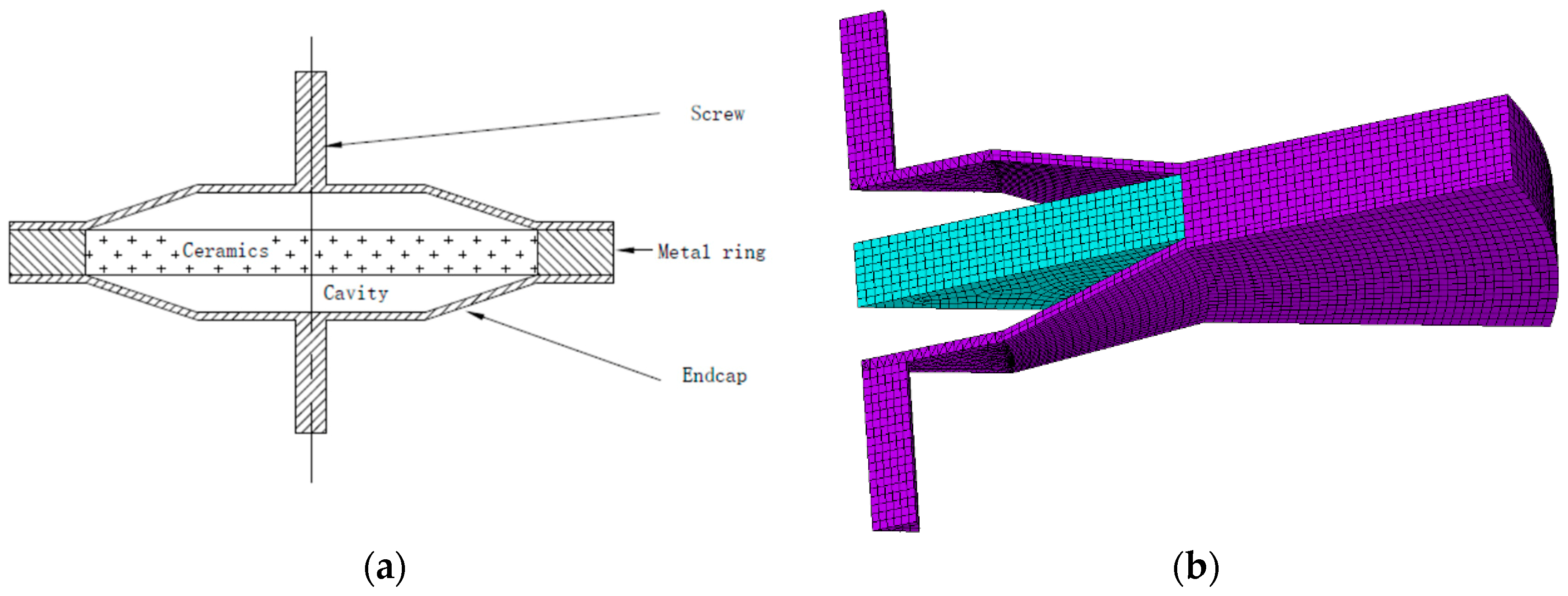
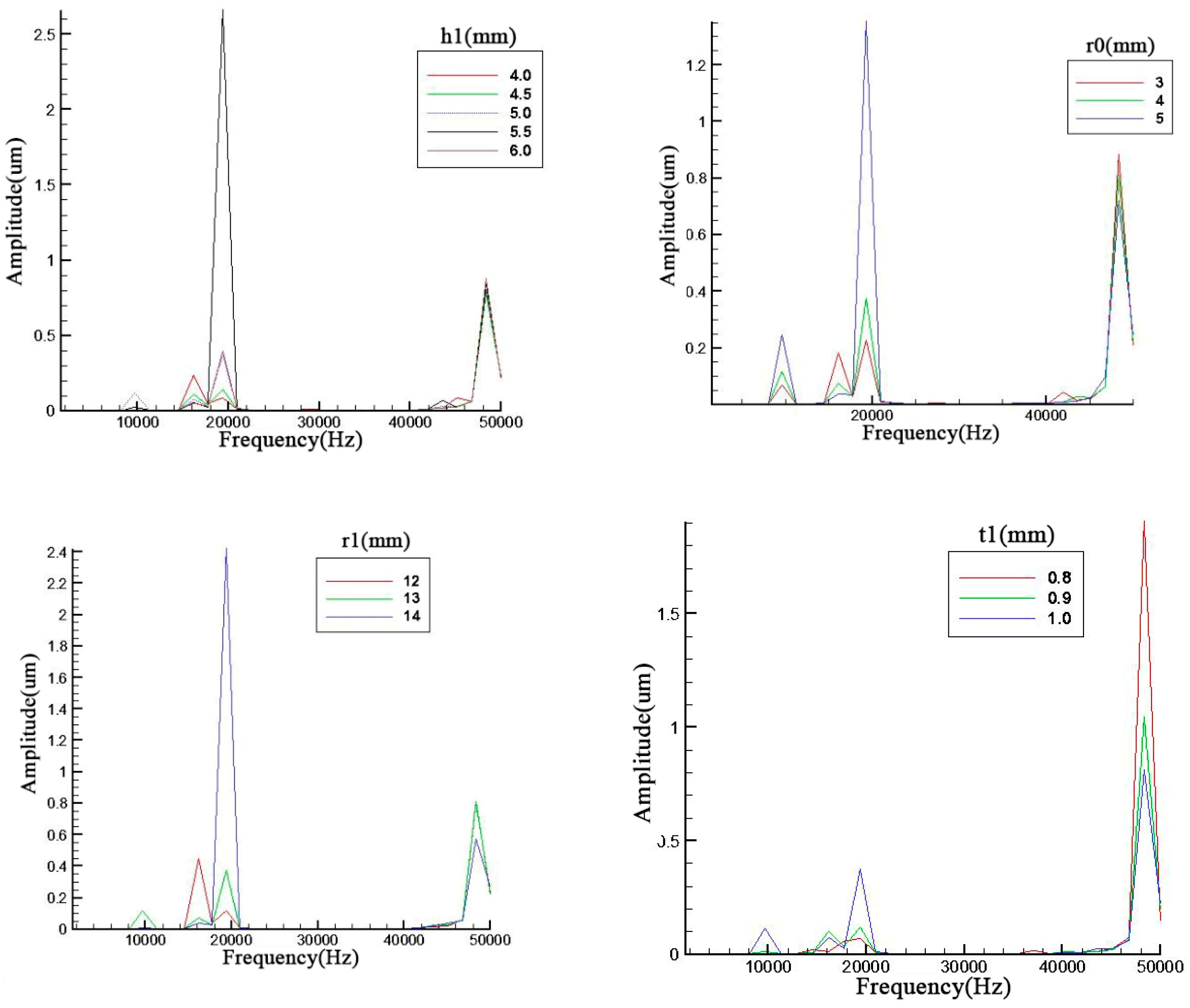
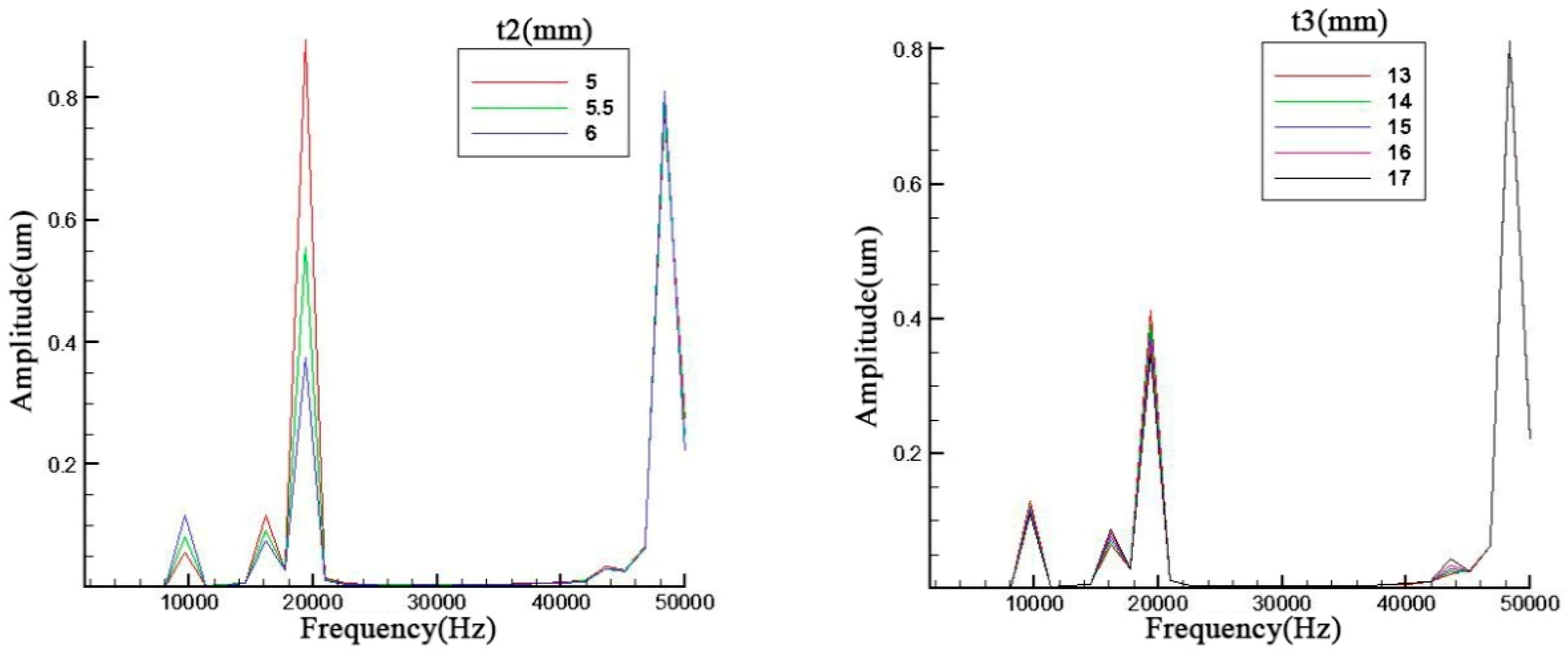
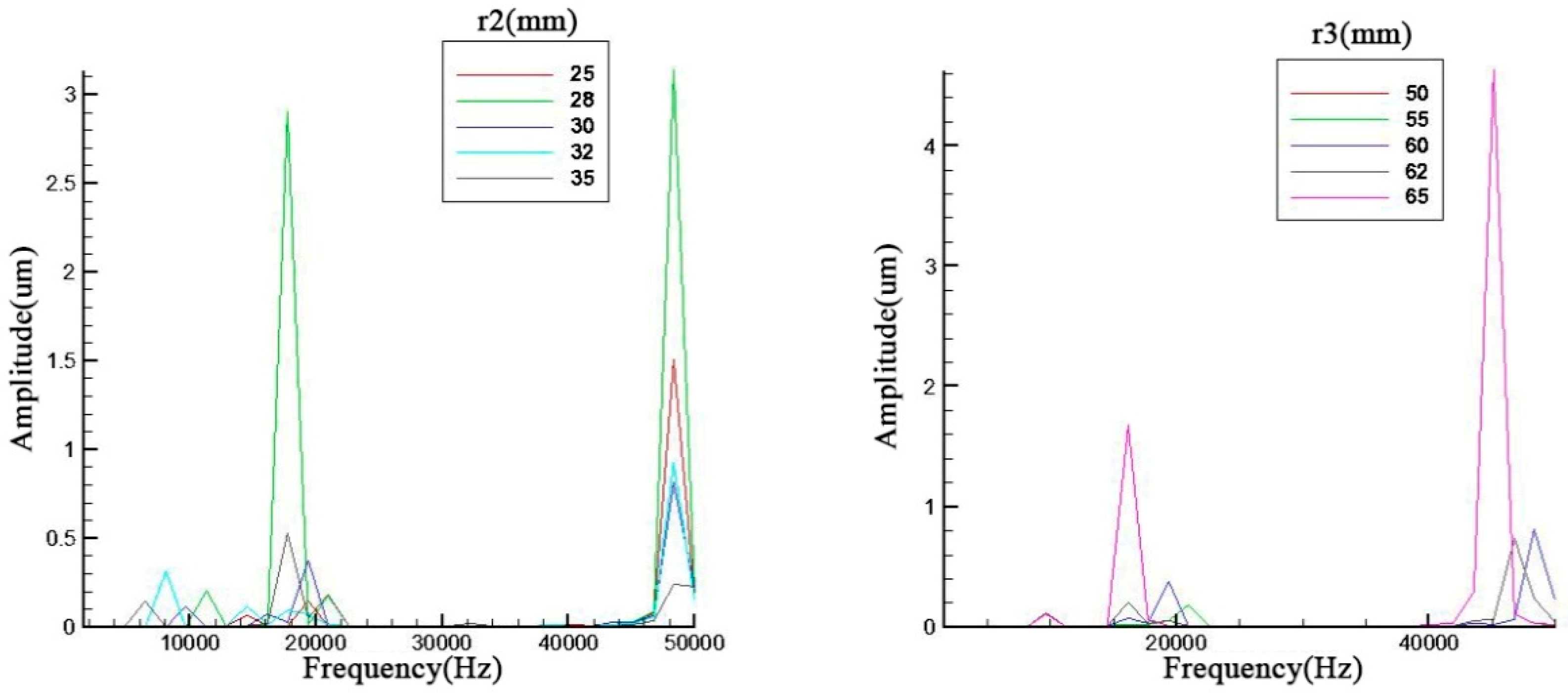
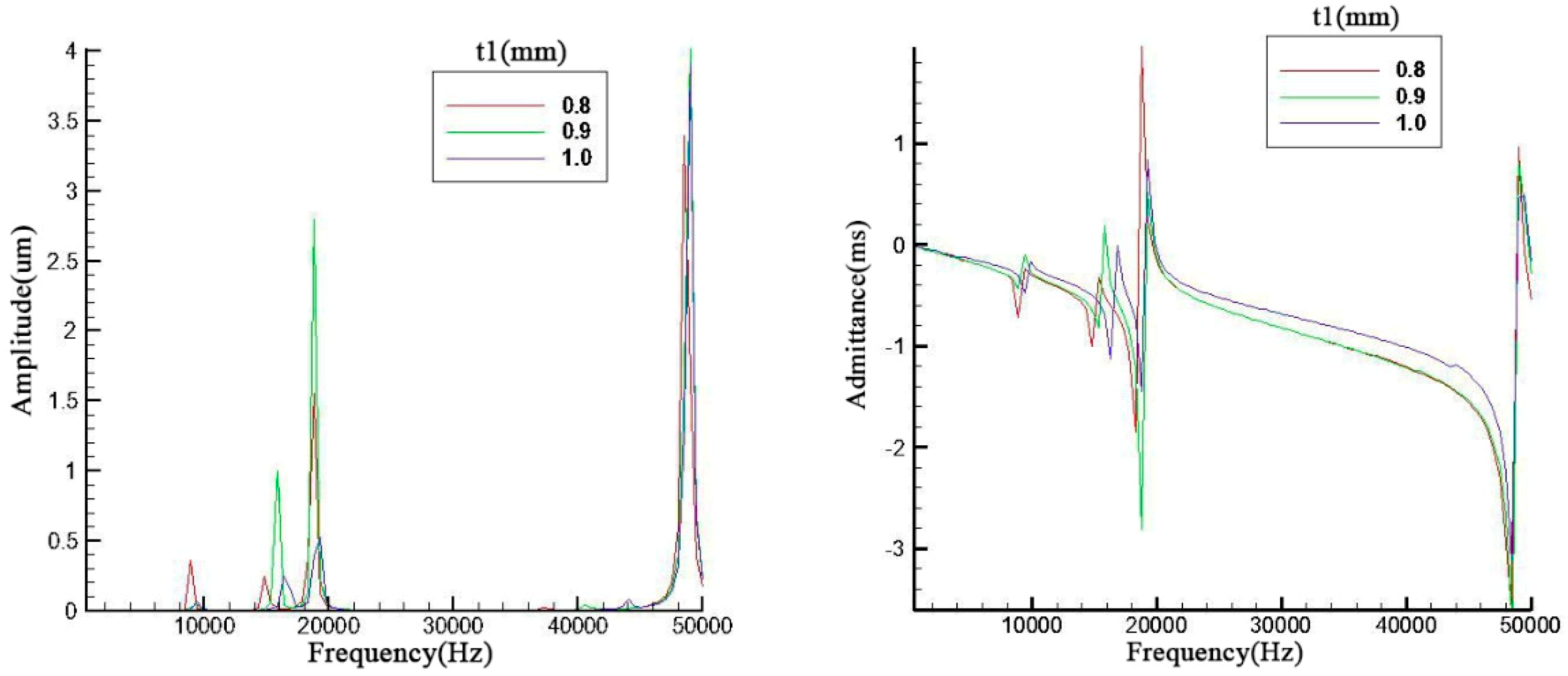

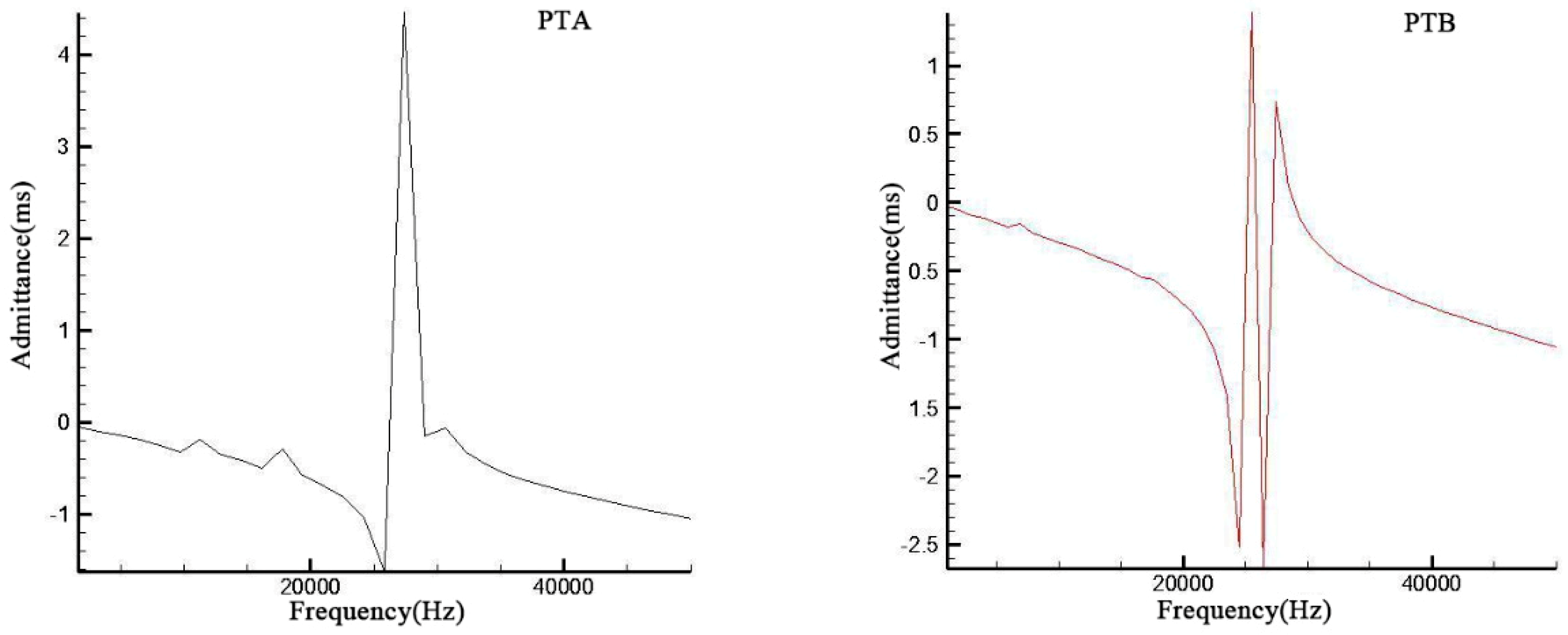
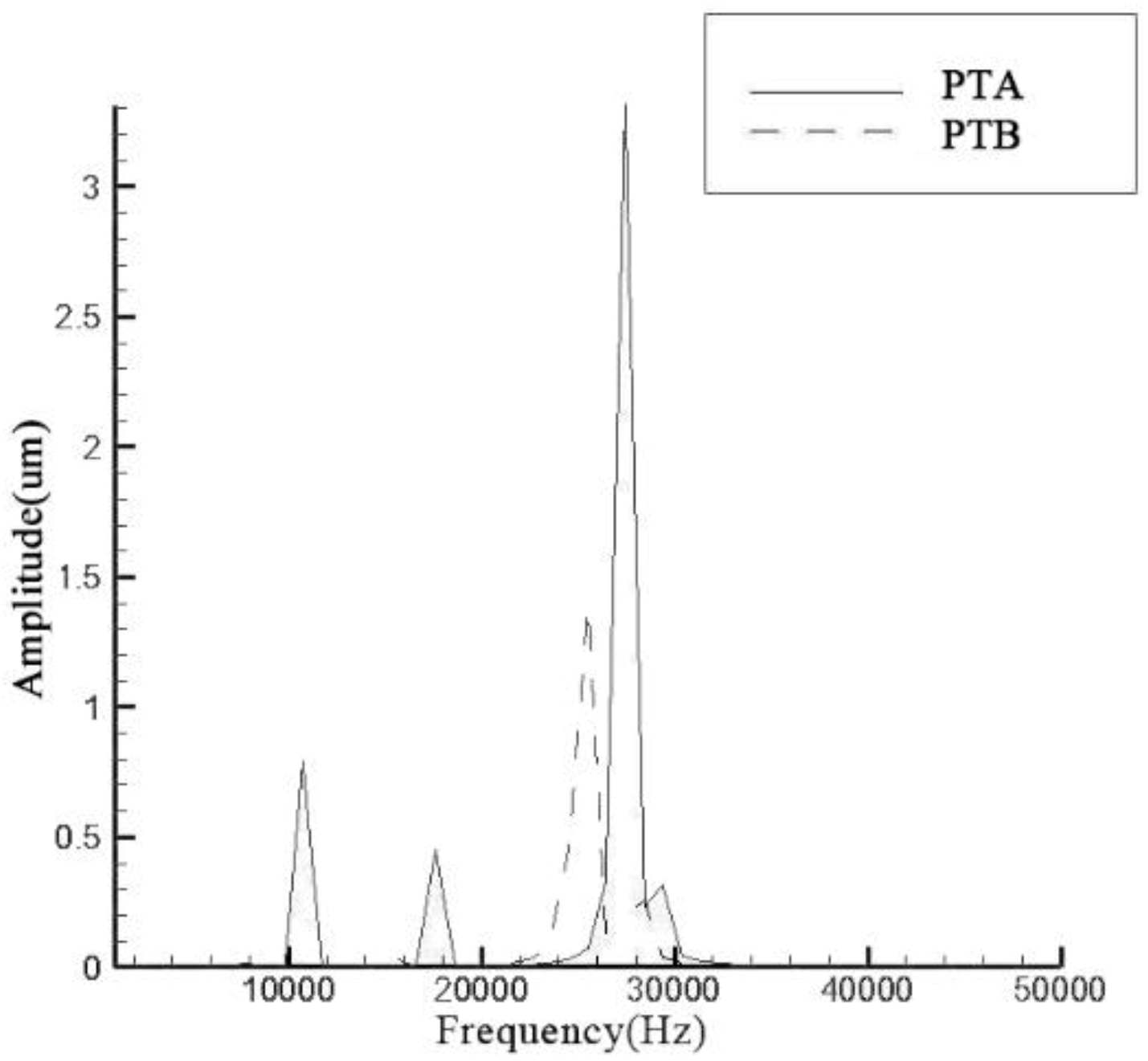
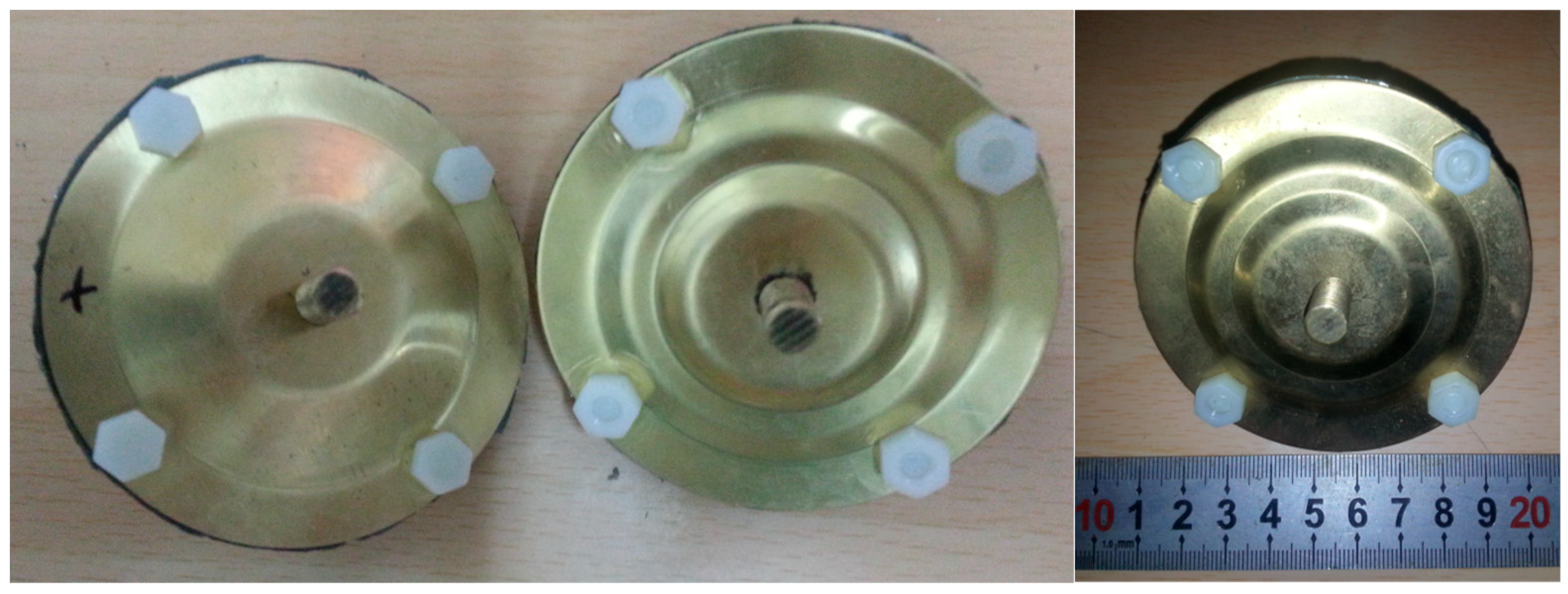

| Ceramics | Piezoelectric Stress (C/m2) | Relative Dielectric | Elastic Stiffness (1010N/m2) | |||||||||
|---|---|---|---|---|---|---|---|---|---|---|---|---|
| PZT5 | −5.4 | 15.8 | 12.3 | 916 | 830 | 830 | 12.1 | 7.54 | 7.52 | 11.1 | 2.11 | 2.26 |
| PZT4 | −5.2 | 15.1 | 12.7 | 730 | 730 | 635 | 14.9 | 7.78 | 7.43 | 11.5 | 2.56 | 4.06 |
| Transducer Name | Screw Radius | Screw Length | Endcap Radius | Endcap Thickness | Ceramic Radius | Ceramic Thickness | Ring Radius | Cavity Depth | |||
|---|---|---|---|---|---|---|---|---|---|---|---|
| PTA | 4 | 15 | 15 | 1 | 30 | 6 | 40 | 5 | |||
| PTB | 4 | 15 | 15 | 20 | 25 | 1 | 30 | 6 | 40 | 2 | 3 |
© 2019 by the authors. Licensee MDPI, Basel, Switzerland. This article is an open access article distributed under the terms and conditions of the Creative Commons Attribution (CC BY) license (http://creativecommons.org/licenses/by/4.0/).
Share and Cite
Wang, W.; Shi, W.; Thomas, P.; Yang, M. Design and Analysis of Two Piezoelectric Cymbal Transducers with Metal Ring and Add Mass. Sensors 2019, 19, 137. https://doi.org/10.3390/s19010137
Wang W, Shi W, Thomas P, Yang M. Design and Analysis of Two Piezoelectric Cymbal Transducers with Metal Ring and Add Mass. Sensors. 2019; 19(1):137. https://doi.org/10.3390/s19010137
Chicago/Turabian StyleWang, Wenjie, Weihao Shi, Peter Thomas, and Mingsui Yang. 2019. "Design and Analysis of Two Piezoelectric Cymbal Transducers with Metal Ring and Add Mass" Sensors 19, no. 1: 137. https://doi.org/10.3390/s19010137
APA StyleWang, W., Shi, W., Thomas, P., & Yang, M. (2019). Design and Analysis of Two Piezoelectric Cymbal Transducers with Metal Ring and Add Mass. Sensors, 19(1), 137. https://doi.org/10.3390/s19010137






